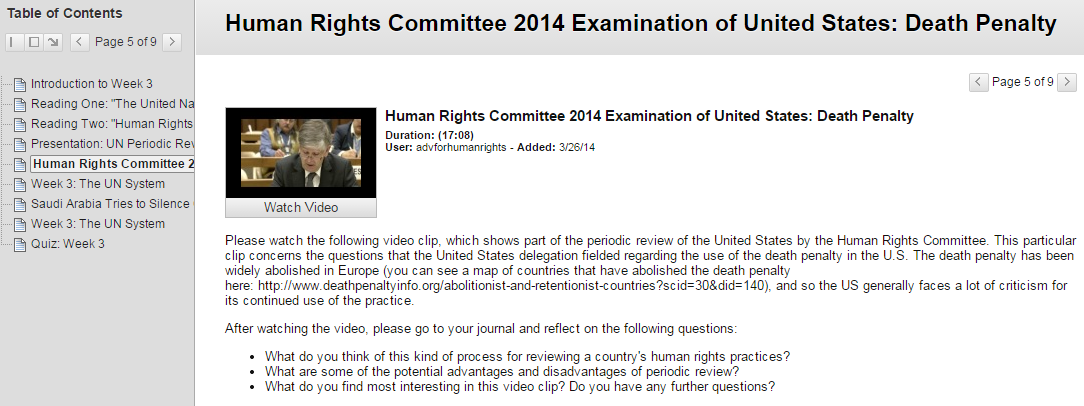In this month’s post, I’m going to discuss some of the advantages of teaching human rights courses in a hybrid format. The hybrid model combines both in-class and online teaching – ideally broken up into two modules each week, one online and one in the classroom. As it combines multiple teaching methods, I have found this style of instruction to allow for the benefits of both online and in-person teaching while mitigating some of the disadvantages of each. Students still have face-to-face time with their professor, but they also experience the flexibility of an online course.
This semester, I am using this method to teach an Introduction to Human Rights course. My class contains 35 undergraduate students with a range of majors, and, therefore, a varying level of previous knowledge about human rights. Some students can name various components of the Universal Declaration of Human Rights, while others might not be willing to wager a guess in public as to what the acronym “U.N.” actually means. Interdisciplinary pedagogy prioritizes the inclusion of a variety of learning experiences and the provision of adequate time for collaborative learning among students precisely for this reason. Although, in practice, most undergraduate courses encounter this varying level of background knowledge, in interdisciplinary courses, we take it as a given from day one. In my experience, hybrid courses are excellent opportunities to provide space for multiple types of learning while still offering time and a space for easy collaboration.

Pedagogically, a hybrid course offers many benefits. This format allows students to engage with lecture material through online modules at their own pace without sacrificing face-to-face contact with their classmates and professor. Students may also use online modules to watch videos or listen to podcasts in preparation for in-class activities. For example, so far this semester we have done several online modules incorporating media in a way that would be difficult to do in a traditional classroom format. When we were studying the UN, I assigned the students to watch several online videos of Universal Periodic Review proceedings. Between videos, they would reflect on each in their online journal. This exercise allowed them to move through the videos and writing at their own pace and then come to class having already thought through the discussion questions in their journals. The combination of online reflection and in-class discussion can be particularly helpful for students who may feel too shy to contribute in class, but may be more comfortable having the chance to work out their thoughts in a written format.

The second media activity involved asking students to watch one of a variety of television episodes in which torture was portrayed and then complete a reflection handout. These worksheets then served as the basis of our in class discussion that week. Although we could have done a similar assignment in class, by completing the assignment as a part of their online module, the students were able to watch different episodes (from shows like Scandal, 24, Lost, and Homeland). We were then able to devote our class time to comparing the different techniques used to portray torture in the media and how these related to what the students had learned about the Convention against Torture in their online module.
A hybrid model also easily allows for the incorporation of multiple voices and perspectives into lectures and activities. Instead of just acknowledging that scholars differ in their opinion about a topic, for example, an online lecture allows the professor to link to these sources. I can point students to other websites to watch videos or read reports, an exercise that not only increases their knowledge about the topic, but also shows them where this kind of material is available online. This polyvocal approach to constructing online lessons is particularly suitable for interdisciplinary classes that are attempting to teach topics like human rights across the disciplines.
So far, I feel like the class has been going really well, and the students seem to agree. When I gave them a quick survey last week about what format they would most prefer if they were registering for other human rights classes (giving them the choices of hybrid, all in-class, or all online), the hybrid format came out as the most popular. Maybe it’s just the fact that they have to come to class less frequently, but I’d like to think it’s something different.